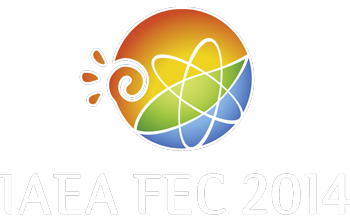Speaker
Dr
Ahmet Y. Aydemir
(National Fusion Research Institute, Daejeon, Korea)
Description
Although ELM control by RMP's has been successfully demonstrated on a number of tokamaks, whether this method will be successful in all anticipated ITER operational scenarios is not clear. Thus, there is a recognized need to investigate other approaches to reducing transient heat and particles loads due to ELM's on PFC's in ITER. A low-cost technique that may not require dedicated equipment is the ELM-pacing with periodic vertical displacement (or ``jogging'') of the plasma. Since its first demonstration on the TCV tokamak, vertical jogging has been shown to be an effective mitigation scheme on ASDEX, JET, and other devices. More recently, KSTAR has demonstrated ELM control and mitigation using a number of different techniques, including vertical jogs of the plasma.
However, a general understanding of the physics consistent with all experimental observations is still missing. On TCV, ELM triggering by vertical jogs is attributed to increased edge currents induced by the plasma displacement away from the X-point. On ASDEX, however, ELM's are triggered when the plasma is moving towards the X-point, with a decrease in the edge currents. The peeling-ballooning stability boundary sensitively depends on the parallel current and pressure profiles at the edge, both of which are affected by plasma displacements. In particular, the current is modified both inductively and through induced changes in the pressure gradient. The inductive component seems to play a dominant role in the TCV results, consistent with the fast time-scale of the “kicks.” Results from other tokamaks are in qualitative agreement with the assumption that the changes in the pressure gradient, either directly (at the ballooning boundary) or indirectly through its effect on the bootstrap current (at the peeling boundary), play a more significant role in triggering ELM's. A more quantitative comparison with experimental results and possible implications of this method for ELM-mitigation in ITER await detailed stability calculations.
| Country or International Organisation | Korea, Republic of |
|---|---|
| Paper Number | TH/P2-2 |
Author
Dr
Ahmet Y. Aydemir
(National Fusion Research Institute, Daejeon, Korea)
Co-authors
Dr
ByoungHo Park
(National Fusion Research Institute, Daejeon, Korea)
Dr
Hyungho LEE
(National Fusion Research Institute)
Dr
Hyunsun HAN
(National Fusion Research Institute, Korea)
Dr
JaeChun Seol
(National Fusion Research Institute)
Dr
Jayhyun Kim
(National Fusion Research Institute)
Dr
Jin Yong Kim
(National Fusion Research Institute, Korea (south))
Prof.
O. J. Kwon
(Department of Physics, Daegu University, Gyeongbuk, Korea)

